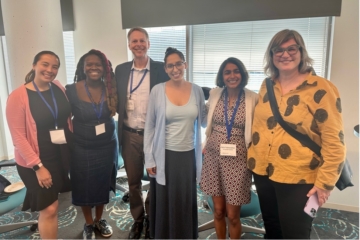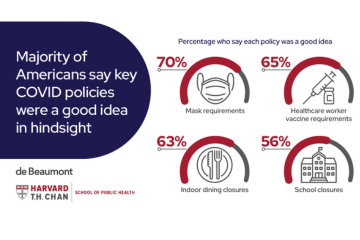When discussing emergency preparedness and response related to COVID-19, frontline efforts such as testing, contact tracing, and community engagement obviously come to mind. But communications is another fundamental component of public health emergency preparedness and response. As the pandemic has shown, communications has a vital role in the health, safety, and decision-making ability of the public.
The Society for Health Communication‘s 4th Annual National Summit for Health Communication virtually convened a group of experts who discussed the responsibilities, considerations, and priorities for the field. Here’s what several speakers had to say about practicing health communications in this public health crisis.
Factor in Uncertainty
Over the past few months, the phrase “in these uncertain times” has been repeated countless times in media, from TV commercials to tweets. It’s this high level of uncertainty throughout the pandemic that must be factored into communications strategies, said Glen Nowak, director of the Center for Health and Risk Communication and professor of advertising at the University of Georgia Grady College of Journalism and Mass Communication.
“COVID-19 has illustrated that when we fail to set, guide, and manage expectations, things don’t go well, we lose credibility, we lose trust, and we give fuel to those who want to focus on whatever side of the fence that they’re on,” Nowak said.
To improve the effectiveness of communications efforts, “we have to figure out how we can account for high uncertainty on many fronts,” he said. Among those considerations: political disagreements regarding public health recommendations and an information overload from multiple sources — some of which are less reputable than others.
Fight Misinformation
World Health Organization Director-General Tedros Adhanom Ghebreyesus declared in February, “We’re not just fighting an epidemic; we’re fighting an infodemic.” Since then, of course, COVID-19 has become a pandemic, and the amount of misinformation surrounding the virus has swelled. Health communications play a key role in tamping down the infodemic and infusing facts into the public discourse.
Tara Kirk Sell, assistant professor in the Department of Environmental Health and an engineering senior scholar in the Center for Health Security at the Johns Hopkins Bloomberg School of Public Health, discussed the types of misinformation that have resurfaced in the pandemic — namely false cures, conspiracies, fake information about COVID-19, and scapegoating of marginalized groups of people.
Diverse partners are needed to combat misinformation, according to Sell. While technology companies such as Facebook have made strides in curbing falsehoods online, “I don’t really think that the solution is to ask tech companies to tell us what’s true or not,” she said. Rather, we need a “multi-pronged approach” involving a range of stakeholders, including health communicators, government officials, scientists, and members of the general public.
An environment in which conspiracies are persistent and people are more connected than ever makes “a perfect storm” for an infodemic, said Peter Adams, senior vice president of education at the News Literacy Project. But there is a bright spot, even as the concurrent pandemic and infodemic overlap and share some disturbing similarities in how their spread: A “vaccine” exists for the infodemic, in the form of news and information literacy and taking care with what is shared.
Promote Health Literacy
Health literacy is a powerful tool, akin to a “deflector shield in the face of disease and misinformation,” said Stacy Robison, president and Co-Founder CommunicateHealth, Inc. What makes this skill so valuable? “Health literacy can be linked to individual empowerment, and this ability to participate in decision-making about our own health [and] the health of our families,” Robison said. “So viewing health literacy as an asset helps us appreciate its potential to act as a protective factor in the face of complex health crises like the one we’re in today.”
She noted that three of the Centers for Disease Control and Prevention’s six principles of Crisis and Emergency Risk Communication (CERC) are especially relevant to promoting health literacy: Be Clear, Be Credible, and Express Empathy. “This is a time for empathy and compassion, not condescension,” she said. “And if we can communicate clearly and authentically, we can empower people with newfound health knowledge and understanding and agency. And that will help build up their protective health literacy deflector shields, and we will all be better off because of it.”
Adapt to the Moment
Even though COVID-19 is a public health priority in virtually all communities, many people continue to struggle with behavioral health conditions. And in some cases, these issues may be complicated by the virus. Take youth vaping, which is still an urgent matter for the U.S. Food and Drug Administration.
“Our work around youth vaping and the youth vaping epidemic continues,” said Tesfa Alexandar, director of the Division of Research and Evaluation at the agency. He added, “it’s a busy time for us as we continue to work on not just addressing COVID-19, but also continuing to address the youth vaping epidemic, and how we adapt and change in the midst of the pandemic knowing that there are still high rates for youth use of e-cigarettes.”
Alexandar discussed the FDA’s revamped messaging strategy in light of the pandemic, accounting for the increased awareness of lung health, as well as greater media consumption as more people are staying at home. The agency is bolstering its media presence, focusing on messaging that speaks to lung health and less on other consequences of tobacco.
Address Health Disparities, Now and in the Future
Longstanding health disparities have risen to the surface — and been exacerbated — in the pandemic. As these disparities have been placed front and center, Stephen B. Thomas, professor of health policy and management director of the Maryland Center for Health Equity at the University of Maryland School of Public Health, called for greater recognition of injustices for a better future.
“We know now more than ever about how to actually prevent the chronic diseases that are the underlying conditions of COVID-19. But it took COVID-19 to put health disparities and the social determinants of health on the front pages of the newspaper,” Thomas said. “And so, whatever we go to in the aftermath of the pandemic cannot be back to status quo.”
He pointed to the Maryland Center for Health Equity’s Building Trust Between Minorities and Researchers project, which seeks to increase the participation of minority populations in health and medical research, and in turn, support improved community health. “Our strategy is to really focus on the social context that shapes people’s attitudes and behaviors and to uncover a whole range of issues” across social determinants of health, Thomas said. “COVID-19 has exposed all of this for us.”





